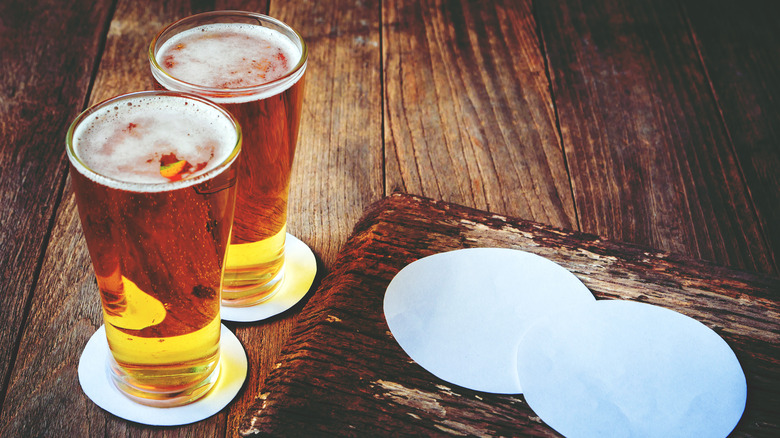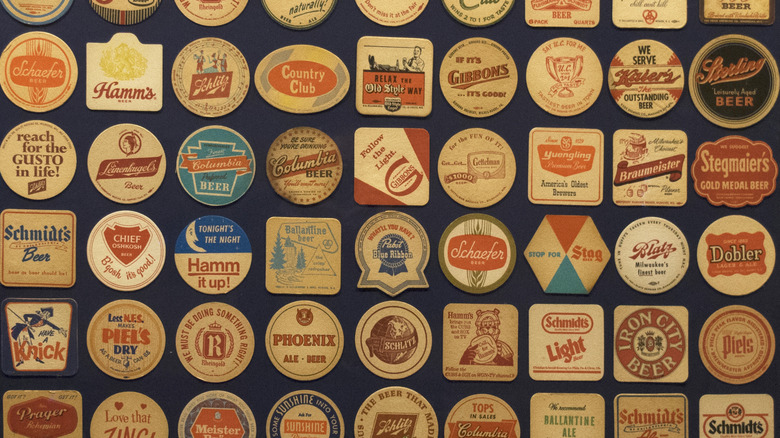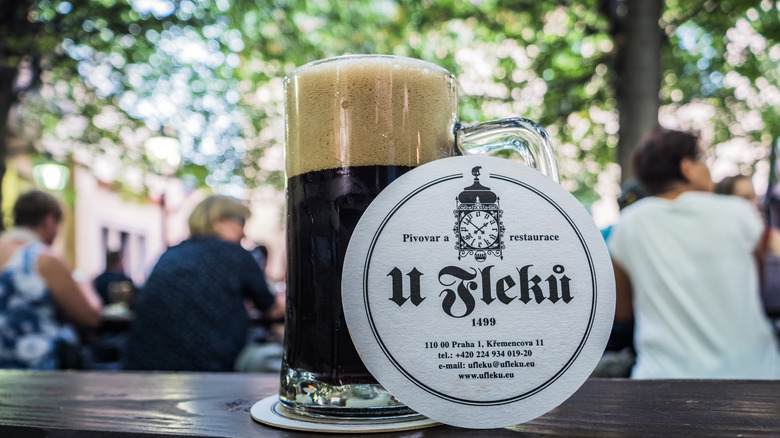The History Of The Drink Coaster
The world's beer drinkers go through a colossal amount of coasters a year, nearly 5.5 billion (per Tales of the Cocktail Foundation). The coaster's versatility could be the reason behind this unfathomably high number. Coasters can protect a bar's surface from condensation, and they also serve as one of the world's earliest forms of advertising, as Condé Nast Traveler notes.
Traditionally, German bars use beermats for advertising the specific beer they serve. In the U.S., restaurants, and bars offer a variety of beers, so they tend to promote the restaurant itself on their coasters (per Eater). Lately, beermats have started sporting social media handles. In Germany, along with a restaurant's preferred beer, coasters advertise messages from political parties (per Condé Nast Traveler).
In Cologne, Germany, bartenders and waiting staff even use cardboard coasters to keep bar tabs. On one side, they will tally how many drinks you've consumed. On the other side, they will calculate the total bill. Keeping a tally may be particularly important in the Cologne region because of the popularity of kölsch beer there. Kölsch is made with low carbonation and bars serve the drink in a small glass that holds less than half a typical glass to prevent the drink from going flat. Because of that, kölsch drinkers will consume many more glasses than the average bar patron. Hence, the need to be more vigilant about the tab.
Bierdeckel: the world's first coasters
Originally, bartenders and patrons placed coasters on top of their glasses to prevent bugs, dirt, and other unsavory substances from spoiling their drinks, according to Tales of the Cocktail Foundation. These early coasters were made of felt and were embroidered with designs. Like the modern-day coaster, fabric coasters were versatile and could be used to wipe up spills (via Eater). Unfortunately, early fabric coasters were never washed, making them a less-than-desirable sanitary tool. Wealthy beer drinkers in Germany could afford krugs (steins) — porcelain mugs with metal lids as Condé Nast Traveler notes. The rest of the bar-goers relied on the flimsy unwashed fabric. Something had to give.
Finally, in the 1880s, the German printing company, Friedrich Horn, came up with a solution: cardboard. The bierderkel soon got an upgrade thanks to Robert Sputh when he patented a bierderkel made of wood pulp, a much stronger material (per Tales of the Cocktail Foundation). Soon, the bierderkel moved beneath the glasses, protecting tables from condensation. Those using the expensive krugs had previously used ceramic coasters under their drinks. Still, the ceramic coasters were heavy and broke easily (via Eater). Soon the sturdy and affordable bierderkel became the standard worldwide. By the mid-20th century, coasters could be found in a variety of materials and designs. They also moved out of the pub, becoming home decor staples (Tales of the Cocktail Foundation).
Can I take coasters home?
Yes. Taking cardboard coasters is encouraged since they're often used to spread a message or advertise a brand (per Eater). Perhaps the only faux pas you can commit is tearing up coasters and leaving the pieces for bartenders to clean up, says Rhode Island mixologist Lori Dhal (via Tales of the Cocktail Foundation).
Those who collect coasters even have an official name: tegestologists. Some tegestologists focus on rare or historic coasters. Others use the paper disks to commemorate favorite pubs and travel memories. According to the Guinness Book of World Records, Austrian Leo Pisker has the world's most extensive collection of coasters totaling 150,000 different designs hailing from over 160 countries. Even coaster makers themselves have favorites. Ralf Korz of Germany's Katz Group, a coaster-making company, cites the tequila-infused beer Salitos as his favorite design: two green sugar skulls with glistening foil eyes (per Eater).
In 2016, the "bible on a beer mat" campaign made headlines. Celebrating the 500th anniversary of the reformation, The Protestant Church in Hesse and Nassau (EHKN) distilled the bible into three key phrases, printed them on coasters, and distributed them throughout Germany: "Love God; Love yourself; Love others." However, the group received criticism for using church taxpayer funds to foot the bill. EKHN spokesman Volker Rahn said of the campaign, "Beer mats point back to pubs and other places where people sit and discuss the fundamental questions of life," as DW reports.


